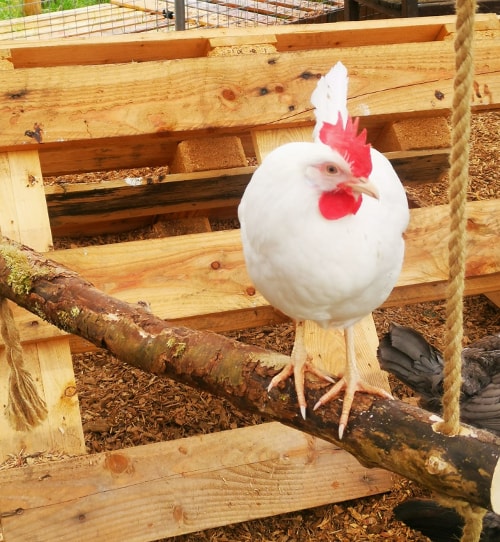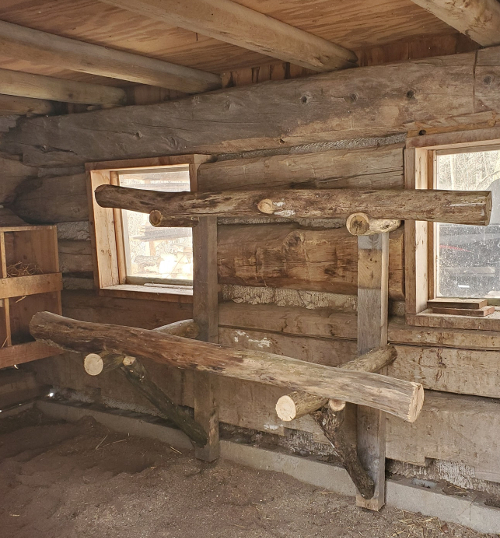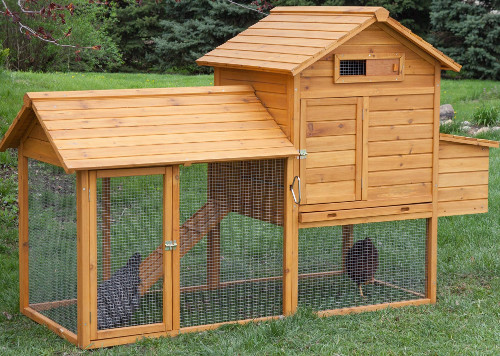Can a coop be too big or too small

Hen houses can be too big or too small but big is much less of a problem. The chicken coop is where your chickens will spend about a third of their lives so it makes sense for it to be a comfortable size.
It is the first buy you make before getting your birds and is likely to be the biggest investment you make whether you build it yourself or buy one.
If your flock are not happy they will not use it and will end up roosting outdoors and laying in hedges.
Can a chicken coop be too big?
No, aside from a few technical and financial considerations bigger is usually better when it comes to hen houses.
I'm in the bigger is better camp and all my chicken coops start their lives as large sheds, even my breeding trio's get a 4 foot by 6 foot shed that is 6 foot tall. Walk-in coops are way easier to deal with, and more room gives you more options.
Below: A large coop means you can have all sorts of extra perches, swings and toys.

Bigger is also a bonus if, like I had to a few years ago, needed to confine my chickens indoors because of an outbreak of bird flu.
Chicken arks and movable coops can be too big, you will need to drag it around somehow.
A few things to check before getting a large coop:
- Will your neighbours think it is too big.
- Bigger is more expensive.
- Check city or council ordinances or town planning regulations.
- Will it be an inefficient use of space.
- You may have issues with heating or cold, but that would depend on where you are and what type of winters you get.
- Can you ventilate a large coop effectively in a hot summer.
- With greater size comes greater target for predators and vermin.
I had some birds that were just given the run of the yard, they used to sleep in the rafters of an old barn nearly 20 foot up. It was probably big enough to get 200 chickens in the eaves but my 8 were always in the same spot and snuggled up nest to each other.
Even if the coop is huge they will find their own favourite corner.
Besides taking more time to clean oversized coop is still preferred above an undersized coop.
Below: A large means you can express your creativity.

Also, if you are like most chicken keepers you will soon find yourself wanting more than four chickens. Having room for expansion will be great versus later wishing you had built bigger to begin with
Chickens give off some heat, but a few chickens would not be sufficient to warm a very large coop.
These are general guidelines. The bigger the chicken, the more space it needs - so meat birds need more space than laying hens, and full grown pullets need more space than baby chicks.
Also with that much extra space you can always add more chickens and have indoor dust baths so they can be used in all seasons.
With large coop you can fit an automatic chicken door opener.
Can a chicken cop be too small?
A hen house that is too small can lead to all sort of problems like injury, feather pecking and aggressive behaviour among your flock.
Below: Small coops like these can injure birds as there is nor enough space to get down of the perches.

Chickens that are competing for space around feed and water or for perching space or nest boxes will be much more likely to resort to fighting or bullying to get what they want.
Other indication that your coop is too small are:
- Sleeping in nest boxes. Small coop often have the nests and roosts at the same height.
- Pecking and aggressive behaviour. Fighting over limited resources.
- Smell and high ammonia levels.
- Egg laying or roosting outdoors.
- Injury. Birds need a certain amount of space to fly down from a perch.
- Excessive manure buildup and having to clean often.
- Stress and decreased productivity.
- Feather loss and bald patches from rubbing on coop walls.
Cramped chickens that are stressed in an undersized coop will not produce at their full potential.
Chickens fly down from perches and if the coop is too small they will be hitting walls instead of landing gently. The flight from perches distance should be 45 degrees to make sure there is no accidents. So if the perches are 4 foot high then they need to be four foot from a wall.
What about the height of the coop?
Height is one measurement that often gets forgotten. Height equals extra volume when it comes to coop and space inside is always a good idea even if your chickens free range.
Legally there must be at least 45 cm (18 inches) of space above the chicken when it is at the highest point in the coop. So if the birds are roosting at 1 m or 3 foot then the coop must be at least 1.8 metres or 6 foot high, accounting 40 cm for the chickens and the 45 cm space requirement.
Just what is the right size for a chicken coop?
Rule number one is the owner has to be comfortable in the coop as well. It's no good buying a small one if you can't bend down to get the eggs and clean out.
Coop size to type of chickens table:
| Size of chicken | Coop space needed | Run space needed |
| Large fowl | 2 sq foot each | 10 sq foot each |
| Bantams | 1 sq foot each | 5 sq foot each |
| True bantams | 1 sq foot each | 4 sq foot each |
| Broilers | 2 sq foot each | 6 sq foot each |
Broilers need slightly less room because they lead quite short lives.
Don't forget you can increase the size of your run by the floor space in your coop just by raising the coop up 18 to 24 inches.
There are some laws about the minimum chicken coop size:
Where I live there are laws about the minimum size of a chicken coop and the land that must be turned over to them.
For free range chickens the stocking density must not exceed nine laying hens per m² (11 sq foot) of usable area and there must be at least 25 cm of perch per bird. The lowest point of the roof should be at least 20 cm above the chicken.
For confined laying hens there must be at least 750 cm² of cage area per hen and the minimum total area for any cage must be 2000 cm² (22 sq foot).
Don't forget that is usable floor area and doesn't include roosting space, nest boxes, scratching pads and dust baths.
All chickens, even those kept as must must have the five freedoms:
- Freedom From Hunger And Thirst by ready access to fresh water and a diet to maintain full health and vigour;
- Freedom From Discomfort by providing an appropriate environment including shelter and a comfortable resting area;
- Freedom From Pain, Injury Or Disease by prevention or rapid diagnosis and treatment;
- Freedom To Express Normal Behaviour by providing sufficient space, proper facilities and company of the animals’ own kind;
- Freedom From Fear And Distress by ensuring conditions and treatment to avoid mental suffering.
So if your coop is too small the birds might be being kept illegally.
Why are some chicken coops so small?
It is often the cheap prefabricated coop kits that are too small. They are built up from a collection of mass produced panels and are very light weight and not secure at all.
You should try to avoid the small, cheap mass produced coops as they never last and won't keep the predators out.
How do you expand a chicken coop?
Probably the easiest way to expand a chicken coop and make it bigger is to raise it up off the ground, if I raise one of my chicken sheds up it instantly gives me an extra 24 sq foot of ground space that is already covered and sheltered and just the spot for making dust baths in.
The other way is to add a covered run with a solid side to the coop as a second run. Whilst it is technically not making the hen house any bigger it will give more space and be dry.
Conclusion:
Simplicity is the key, it makes things easy to look after, clean and repair and large walk in coops are better for this.
